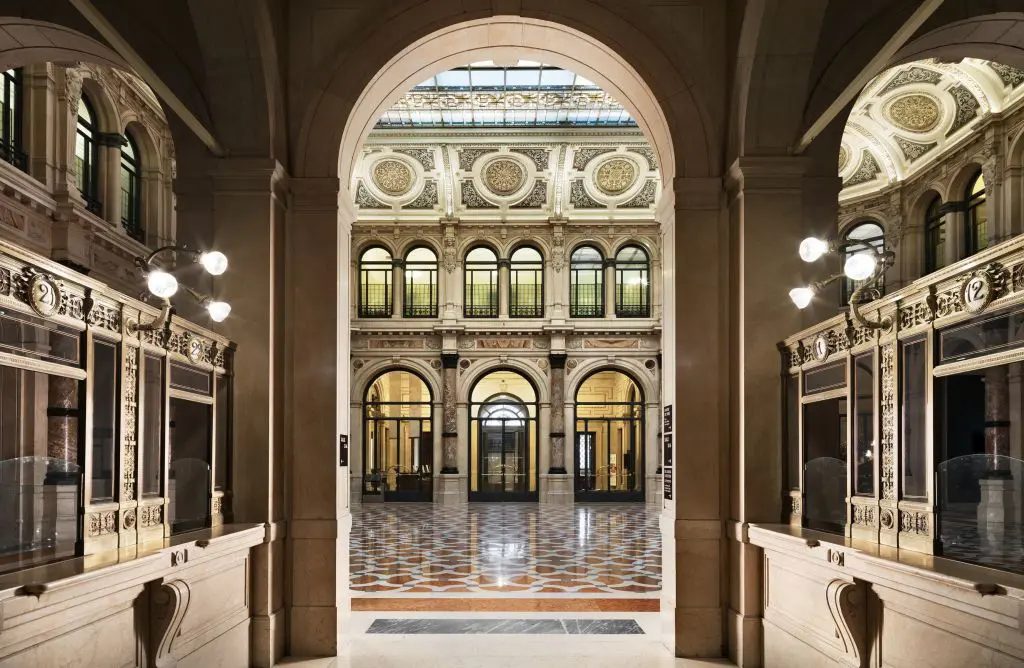TURIN (ITALPRESS) – In 2024, there were 750,000 visitors to Intesa Sanpaolo’s Gallerie d’Italia, the four museums in Milan, Naples, Turin and Vicenza, which were created through the transformation of historic palaces owned by the bank that were previously used as workplaces: thanks to impressive architectural renovations, these valuable buildings have become places dedicated to art and culture for the display of part of the more than 35,000 works of art, including 3,500 of particular value from Intesa Sanpaolo’s collection. Of these, 100 thousand were students from schools of all levels, for whom the activities are free of charge. The activities carried out as part of Progetto Cultura, a multi-year plan of initiatives created at the behest of current Chairman Emeritus Giovanni Bazoli, saw the creation of 12 major exhibitions, 60 collateral meetings and numerous partnerships with Italian and foreign cultural institutions. The commitment to art and culture, which over the years has become an identity value and hallmark of the Group led by Carlo Messina, is part of a massive program that allocates 1.5 billion euros for interventions for Italy by 2027.The first museum was established in Vicenza in 1999, the one in Naples in 2007 and the one in Milan in 2011. In May 2022, the establishment of the fourth museum in Turin, along with the relocation of the Naples Galleries to its new location in Via Toledo, enriched and completed Intesa Sanpaolo’s museum hub. The care of the art collections belonging to the Group is accompanied by attention to the country’s artistic and architectural heritage through Restituzioni, the world’s most important restoration program, which since 1989 has made it possible to “return” more than 2,200 of the country’s artistic assets to the community, with the involvement of the Italian Superintendencies, Regional Museums and Autonomous Museums Directorates and qualified restorers throughout the country, as well as major restoration centers. The Restituzioni exhibition that brings together the properties restored during the 20th edition will take place in Rome in 2025. Also part of the Culture Project’s activities is the management and sharing of Intesa Sanpaolo’s Historical Archive, which collects the vast documentary heritage that belonged to the many banks that became part of the Group.A strong element of innovation in valuation, since 2017, is the constant monitoring of the economic value of the collections compared to the market, through the process of redetermining the fair value of works belonging to the class “artistic heritage of value” through triennial appraisals. Intesa Sanpaolo was the first bank internationally to carry out such an operation that goes far beyond accounting significance as it makes tangible the deep integration between the corporate collection and the life of the company. The model adopted by Intesa Sanpaolo was the subject of a cooperation protocol recently signed at the Ministry of the Interior with the Department of Civil Liberties and Immigration. The Group will lend its expertise to create a measurement model useful for assessing at market value (fair value) works of art, archival and book assets of 862 churches owned by the Fondo Edifici di Culto (FEC) operating at the Department.The extensive collaboration established with the National Gallery, one of the most prestigious museum institutions in the world, is being intensified. Indeed, Intesa Sanpaolo will be the Leading Exhibition Sponsor of the major exhibition “Siena: The Rise of Painting 1300-1350,” which is scheduled to open in London from March 8 to June 22, 2025. Featuring more than one hundred paintings, sculptures, goldwork, and textiles, the exhibition will explore an extraordinary moment at the dawn of the Italian Renaissance and the pivotal role played by Sienese artists such as Duccio, Pietro and Ambrogio Lorenzetti, and Simone Martini in defining Western painting. The exhibition ‘The Last Caravaggiò centered on the Martyrdom of St. Ursula, the main work in Intesa Sanpaolo’s collection usually displayed in the museum at the Gallerie d’Italia in Naples, was, with three hundred thousand visitors – three thousand a day, the third most visited British museum in the last ten years.Intesa Sanpaolo, Fondazione 1563 per l’Arte e la Cultura della Compagnia di San Paolo, and Fondazione Cassa di Risparmio di Cuneo recently announced the relaunch of Umberto Allemandi Editore through the acquisition of 100 percent of the industrial branches of the historic publishing house, a key player in the art world with the title “Il Giornale dell’Arte,” founded in 1983, with publications dedicated to art, architecture, antiques, design, and, more generally, to cultural popularization and contemporary criticism.As of 2018, the Culture Project becomes part of the Business Plan, testifying to its centrality within the vision of a large Bank that, in addition to playing an irreplaceable function in economic development, is also increasingly recognized as a leading player in the social and cultural growth of the country. Intesa Sanpaolo’s Culture Project, managed by the Art Culture and Historical Assets Department, of which Michele Coppola, also General Manager of the Bank’s Gallerie d’Italia, is in charge, falls, as of April 2024, under the Sustainability Governance Area headed by Paola Angeletti. “The year that is coming to an end has been one of results beyond objectives and expectations. I am not only referring to the major exhibition projects carried out in the four Galleries of Italy, which are always original, the result of research and relations with important institutions, but I am also thinking of the growing number of visitors and the activities done with schools and fragile audiences, an identity component of Intesa Sanpaolo’s Culture Project. The main satisfaction is the strong consideration with which the Galleries of Italy are known and recognized, as places that belong to their respective communities, bringing contributions that qualify the cultural proposal of the cities and squares that host them. It is also important to emphasize the breadth of initiatives dedicated to our art collections in other locations in Italy and abroad, thanks to a shared work with other entities that places the Bank among the main European interlocutors in defending and disseminating the national cultural heritage,” said Michele Coppola, Executive Director Art, Culture and Historical Heritage Intesa Sanpaolo and General Director of Gallerie d’Italia.
– photo Intesa Sanpaolo press office-(ITALPRESS).

